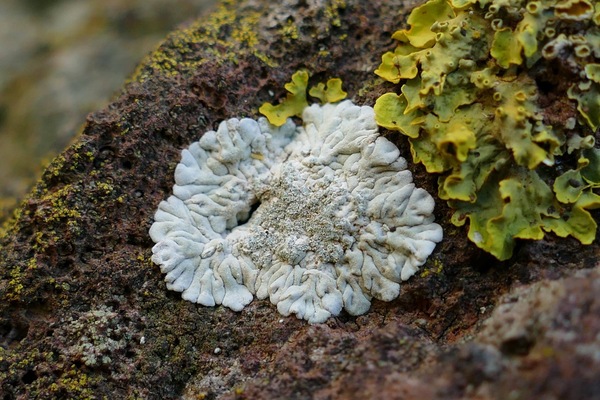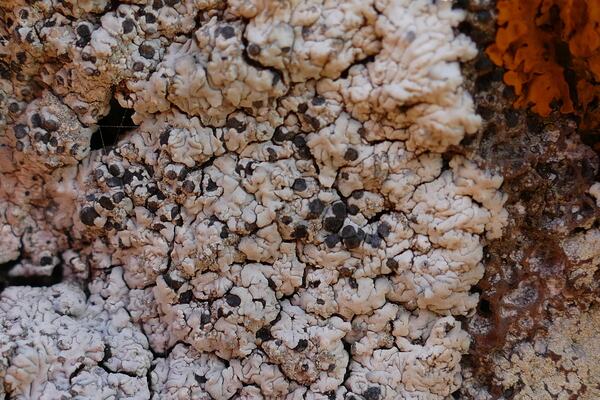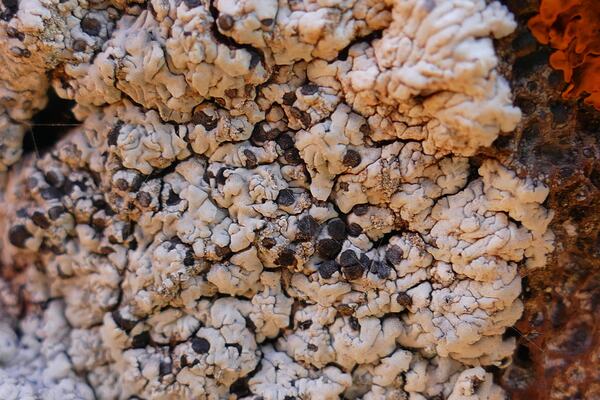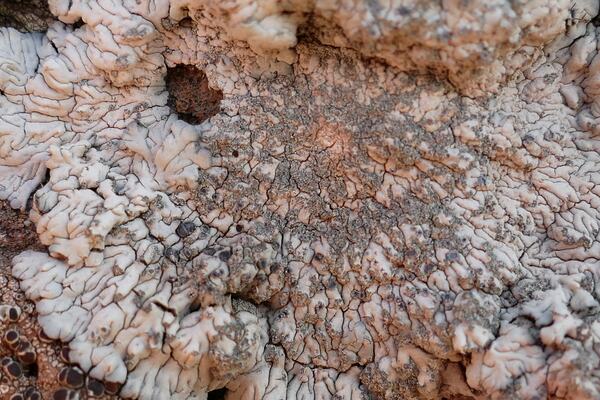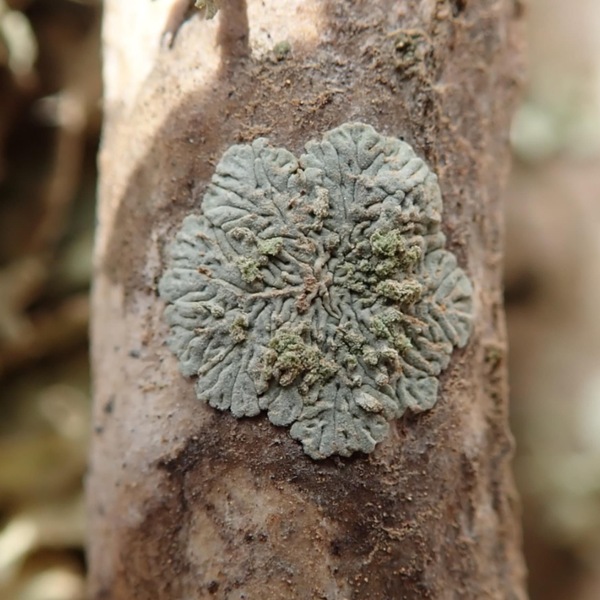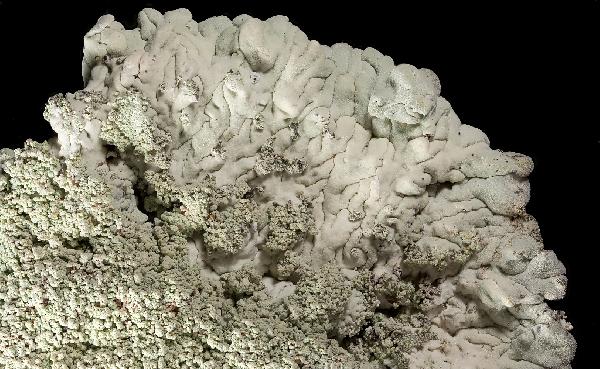Diploicia canescens (Dicks.) A. Massal.
Ric. Auton. Lich. Crost.: 86, 1852. Basionym: Lichen canescens Dicks. - Fasc. Pl. Cryptog. Brit., 1: 10, 1785.
Synonyms: Buellia canescens (Dicks.) De Not.; Catolechia canescens (Dicks.) Anzi; Lecidea canescens (Dicks.) Ach.; Placodium canescens (Dicks.) DC.
Description: Thallus crustose-placodioid, glaucous grey but usually densely white-pruinose, forming 1-4(-6) cm wide, usually orbicular rosettes, sometimes several thalli merging and covering larger surfaces. Lobes radiating from the center, 0.5-1.2 mm wide, contiguous, slightly convex, rounded and often slightly broader and fan-shaped at ends, with laminal, at first orbicular soralia developing from small bulges, finally bursting and irregular; soredia finely granular, greenish white to grey; lower surface usually pale, attached by medullary hyphae. Upper cortex pseudoparenchymatous, formed by vertically arranged hyphae, filled with minute crystals forming chains in K; medulla usually white, lax. Apothecia rare, lecideine, black, up to 1 mm across, laminal. Proper exciple thin, dark brown to black; epithecium granular, brown-black, K-; hymenium colourless, I+ blue; paraphyses simple or forked, the apical cells swollen, with a dark cap; hypothecium brown or brown-black. Asci 8-spored, cylindrical-clavate, the apical dome K/I+ dark blue with a pale, conical-pointed apical cushion (axial mass), the wall I-, but the thin outer gel I+ blue, Bacidia-type. Ascospores 1-septate, grey green to brown, thick-walled, ellipsoid, 9-15 x 4-8 µm Dirinaria-type, with ontogeny of type B (apical inner wall-thickenings produced before septum formation). Pycnidia immersed, brown-black, the wall dark near the ostiole, otherwise colourless, the conidiogenous cells enteroblastic, pleurogenous, branched. Conidia hyaline, short-bacilliform, 5-8 µm x 0.7-1 µm. Photobiont chlorococcoid. Spot tests: cortex K+ yellow, C- or C+ pale pinkish yellow, KC+ brownish yellow or yellow-orange, P- or P+ yellow; medulla K-, C-, KC-, P-, UV+ dull orange. Chemistry: cortex with atranorin and often chloroatranorin, medulla with dechlorodiploicin (minor), isofulgidin (minor), dechloro-O-methyldiploicin (minor or trace), buellolide (minor), canesolide (minor or trace), and secalonic acids A, B and C (minor or trace).
Growth form: Crustose placodiomorph
Substrata: bark and rocks
Photobiont: green algae other than Trentepohlia
Reproductive strategy: mainly asexual, by soredia, or soredia-like structures (e.g. blastidia)
Most common in areas with a humid-warm climate (e.g. most of Tyrrenian Italy)
In underhangs rarely wetted by rain
Commonnes-rarity: (info)
Alpine belt: absent
Subalpine belt: absent
Montane belt: absent
Dry submediterranean belt: extremely rare
Humid submediterranean belt: rather common
Padanian area: absent
pH of the substrata:
1 2 3 4 5
Solar irradiation:
1 2 3 4 5
Aridity:
1 2 3 4 5
Eutrophication:
1 2 3 4 5
Poleotolerance:
0 1 2 3
Altitudinal distribution:
1 2 3 4 5 6
Rarity
absent
extremely rare
very rare
rare
rather rare
rather common
common
very common
extremely common
Loading data...
Occurrence data
Predictive map
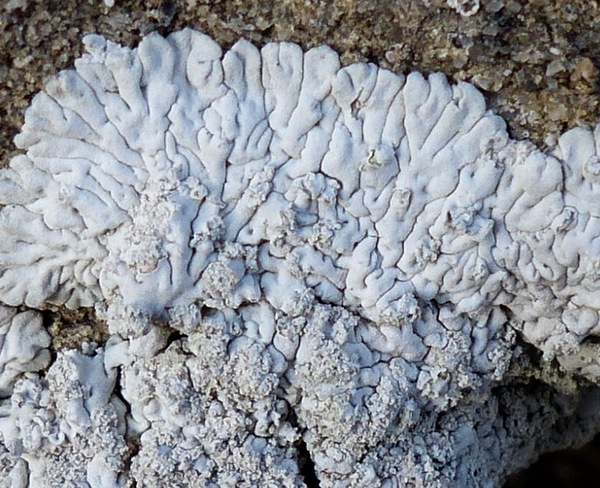
Andrea Moro; Owner: Department of Life Sciences, University of Trieste
Italy, Friuli Venezia Giulia, Trieste, Trieste, Conconello
14/02/2017

G. Incerti; Owner: Department of Life Sciences, University of Trieste
Herbarium: TSB (31403)
2001/11/26
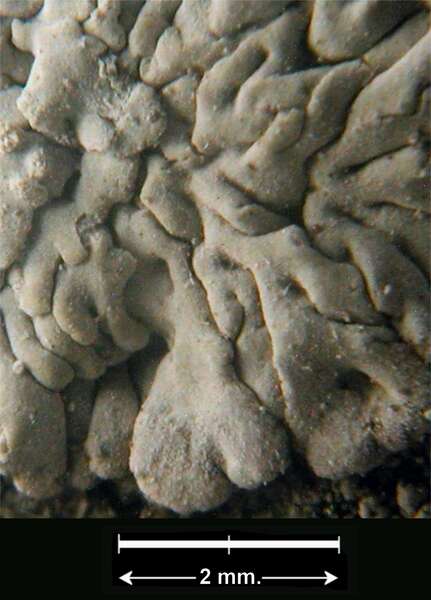
G. Incerti; Owner: Department of Life Sciences, University of Trieste
Herbarium: TSB (31403)
2001/11/26
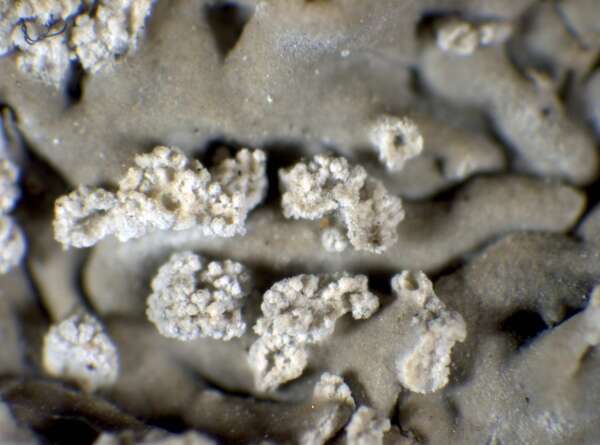
P.L. Nimis; Owner: Department of Life Sciences, University of Trieste
Herbarium: TSB (14683)
2001/11/23
detail of soredia
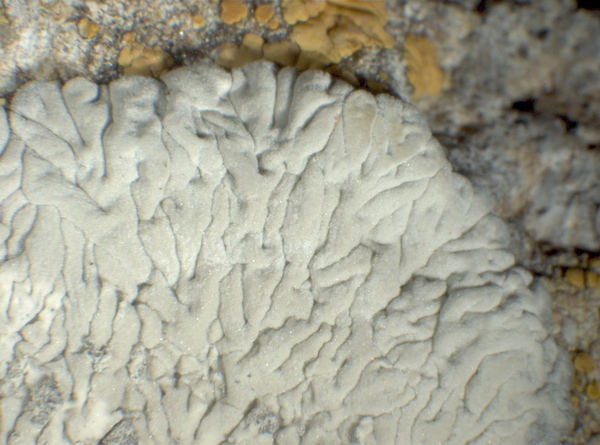
P.L.Nimis; Owner: Department of Life Sciences, University of Trieste
Herbarium: TSB (38226)
2008.02.25
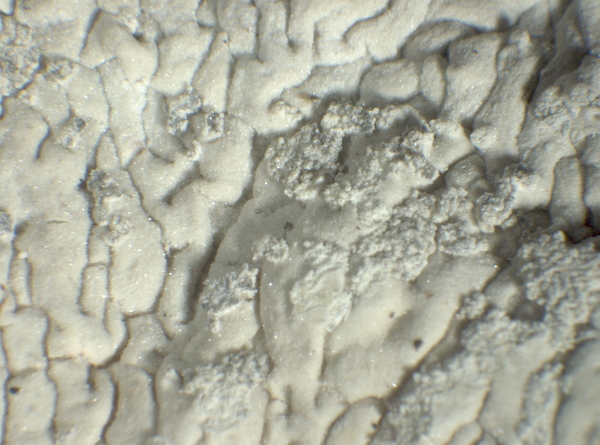
P.L.Nimis; Owner: Department of Life Sciences, University of Trieste
Herbarium: TSB (38226)
2008.02.25
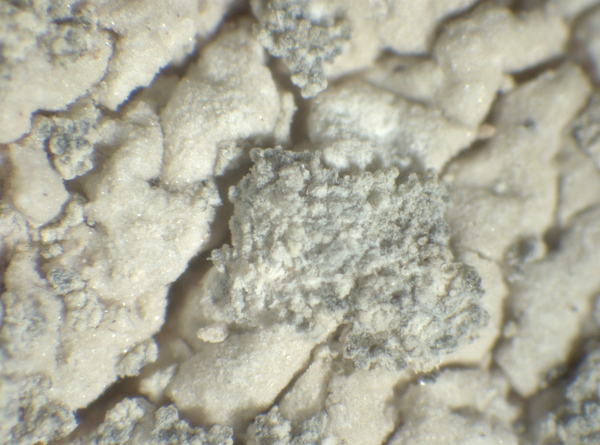
P.L.Nimis; Owner: Department of Life Sciences, University of Trieste
Herbarium: TSB (38226)
2008.02.25
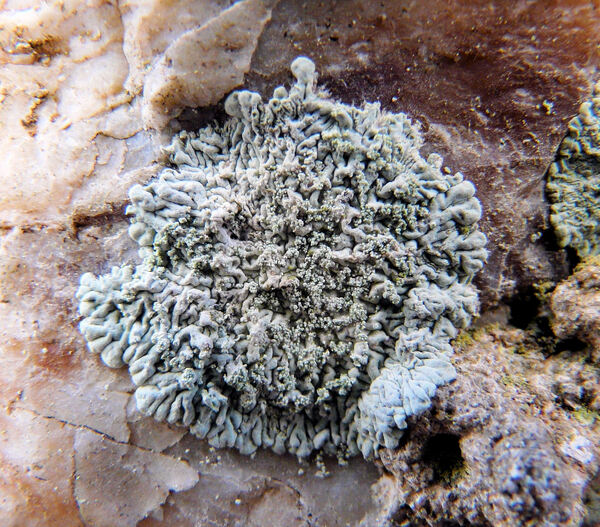
A. Moro; Owner: Department of Life Sciences, University of Trieste
Sicilia, TP, Erice, dintorni della città
2008.04.05

Andrea Moro; Owner: Department of Life Sciences, University of Trieste
Italy, Sicily, Trapani, Erice, Historical Center

Andrea Moro; Owner: Department of Life Sciences, University of Trieste
Italy, Sicily, Trapani, Erice, Historical Center

Andrea Moro; Owner: Department of Life Sciences, University of Trieste
Italy, Sicily, Trapani, Erice, Historical Center
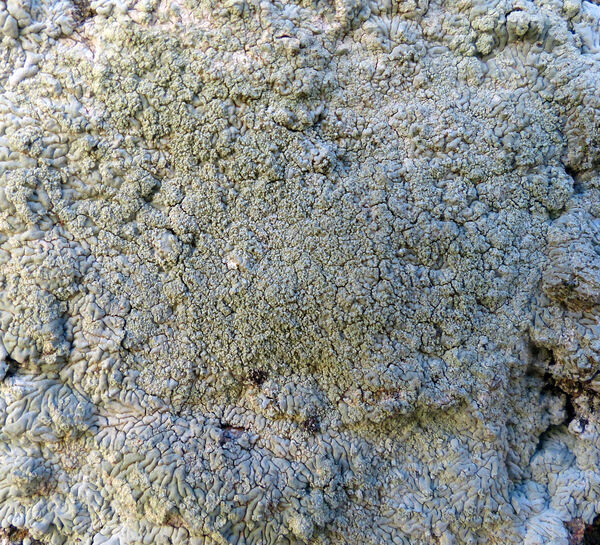
Andrea Moro; Owner: Department of Life Sciences, University of Trieste
Italy, Sicily, Trapani, Erice, Historical Center

Andrea Moro; Owner: Department of Life Sciences, University of Trieste
italy, Friuli Venezia Giulia, Trieste, Trieste Karst near Borgo Grotta Gigante
16/02/2017
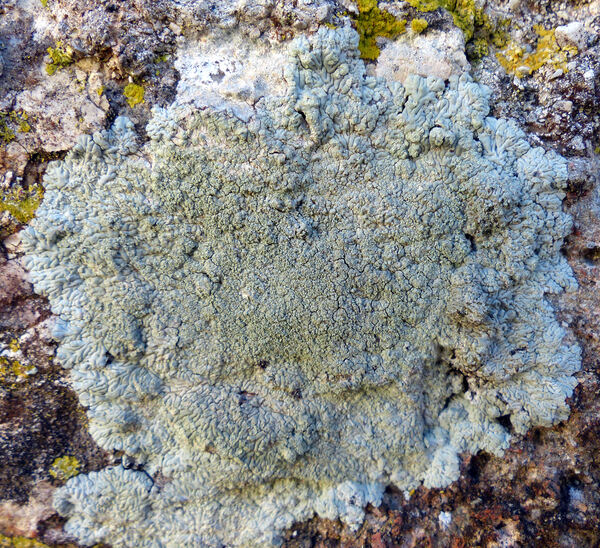
Andrea Moro; Owner: Department of Life Sciences, University of Trieste
Italy, Sicily, Trapani, Erice, Historical Center
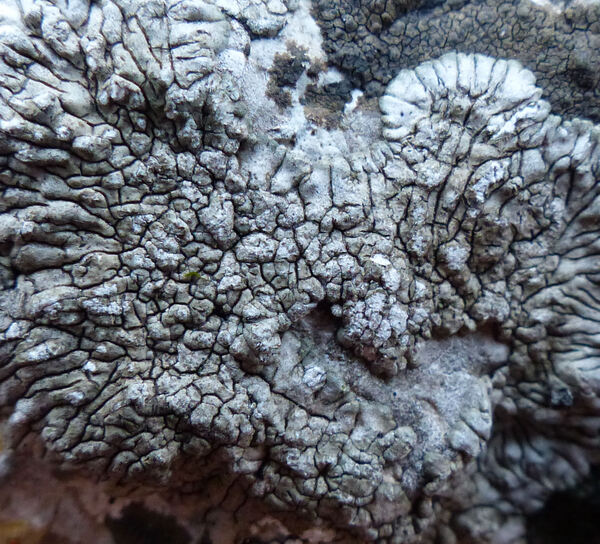
Andrea Moro; Owner: Department of Life Sciences, University of Trieste
italy, Friuli Venezia Giulia, Trieste, Trieste Karst near Borgo Grotta Gigante
16/02/2017
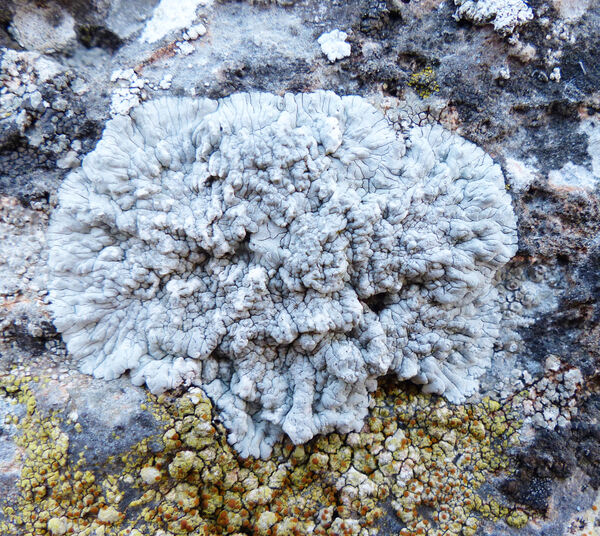
Andrea Moro; Owner: Department of Life Sciences, University of Triedte
Italy, Friuli Venezia Giulia, Trieste, Trieste Karst, Rocca di Monrupino
20/02/2017
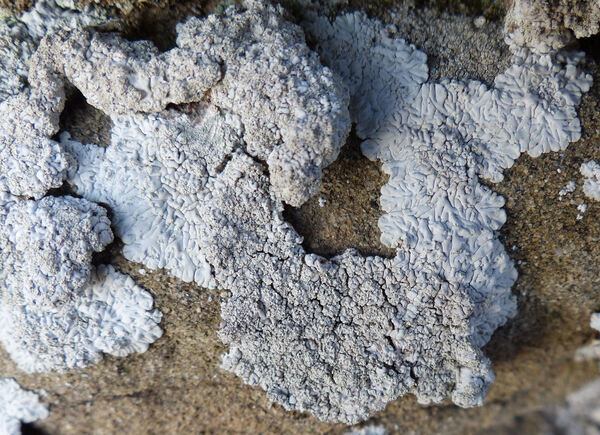
Andrea Moro; Owner: Department of Life Sciences, University of Trieste
Italy, Friuli Venezia Giulia, Trieste, Trieste, Conconello
14/02/2017

Andrea Moro; Owner: Department of Life Sciences, University of Trieste
Italy, Friuli Venezia Giulia, Trieste, Trieste, Conconello
14/02/2017
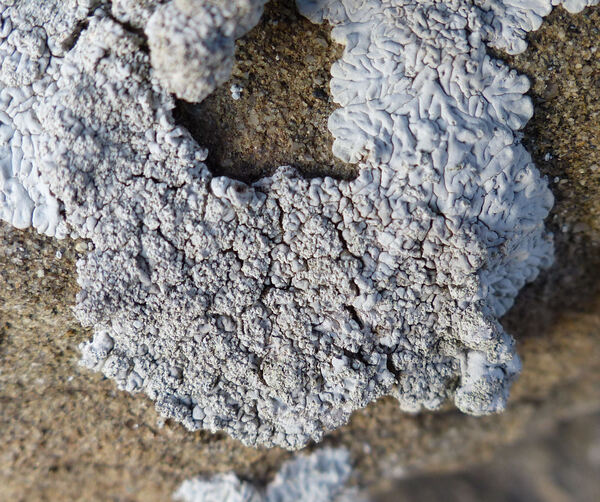
Andrea Moro; Owner: Department of Life Sciences, University of Trieste
Italy, Friuli Venezia Giulia, Trieste, Trieste, Conconello
14/02/2017
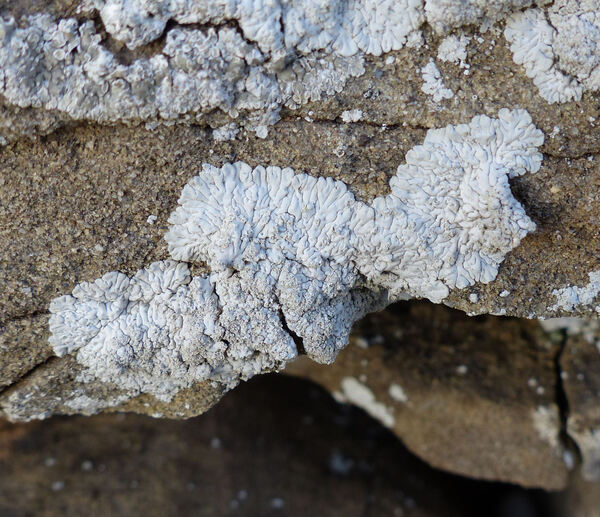
Andrea Moro; Owner: Department of Life Sciences, University of Trieste
Italy, Friuli Venezia Giulia, Trieste, Trieste, Conconello
14/02/2017

Andrea Moro; Owner: Department of Life Sciences, University of Trieste
Italy, Friuli Venezia Giulia, Trieste, Trieste, Conconello
14/02/2017

Andrea Moro; Owner: Department of Life Sciences, University of Trieste
Italy, Friuli Venezia Giulia, Trieste, Trieste, Conconello
14/02/2017
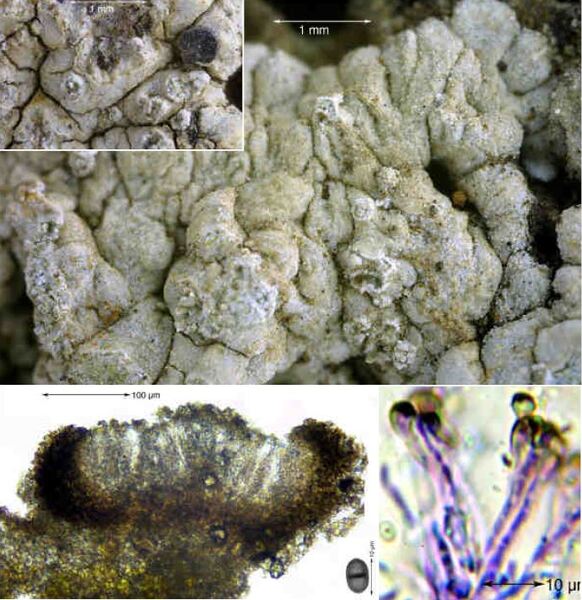
Felix Schumm – CC BY-SA 4.0
Image from: F. Schumm (2008) - Flechten Madeiras, der Kanaren und Azoren. Beck, OHG - ISBN: 978-3-00-023700-3

Felix Schumm – CC BY-SA 4.0
[16352], Mallorca (Süd): Nationalpark; 39,34322° N, 3,16764° E, 40 m. Leg. Schumm, Frahm & Lüth 12.03.2010, det. Schumm 2010.
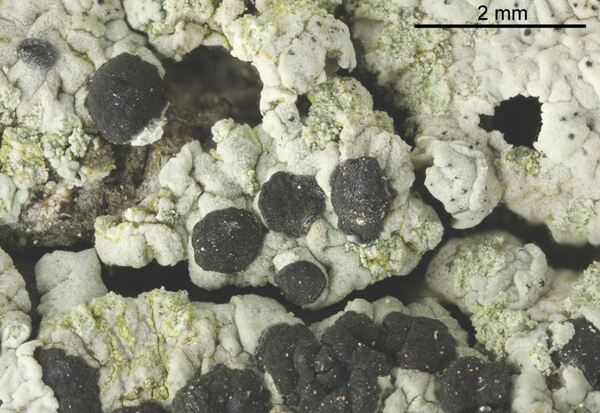
Felix Schumm – CC BY-SA 4.0
[16352], Mallorca (Süd): Nationalpark; 39,34322° N, 3,16764° E, 40 m. Leg. Schumm, Frahm & Lüth 12.03.2010, det. Schumm 2010.

Felix Schumm – CC BY-SA 4.0
[16352], Mallorca (Süd): Nationalpark; 39,34322° N, 3,16764° E, 40 m. Leg. Schumm, Frahm & Lüth 12.03.2010, det. Schumm 2010.
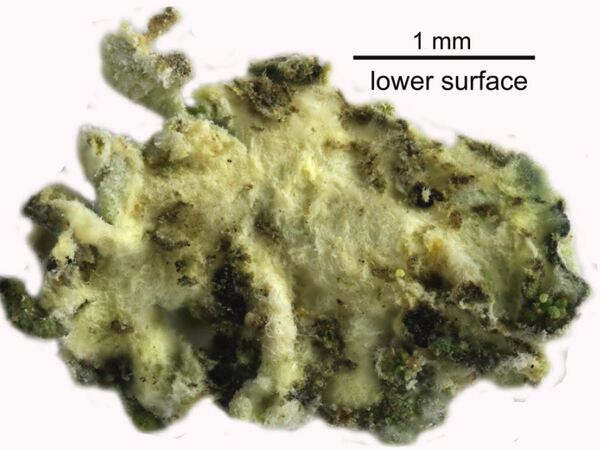
Felix Schumm – CC BY-SA 4.0
[16352], Mallorca (Süd): Nationalpark; 39,34322° N, 3,16764° E, 40 m. Leg. Schumm, Frahm & Lüth 12.03.2010, det. Schumm 2010.
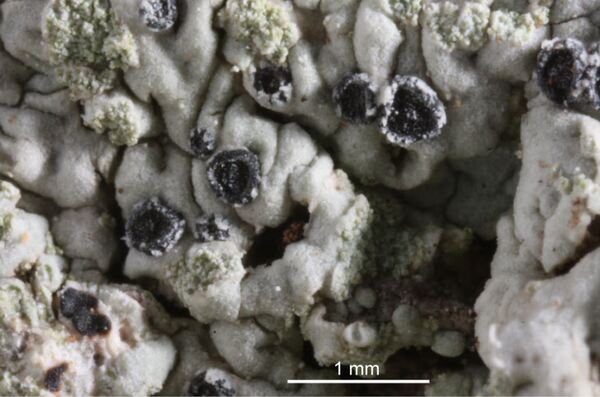
Felix Schumm – CC BY-SA 4.0
[16352], Mallorca (Süd): Nationalpark; 39,34322° N, 3,16764° E, 40 m. Leg. Schumm, Frahm & Lüth 12.03.2010, det. Schumm 2010.
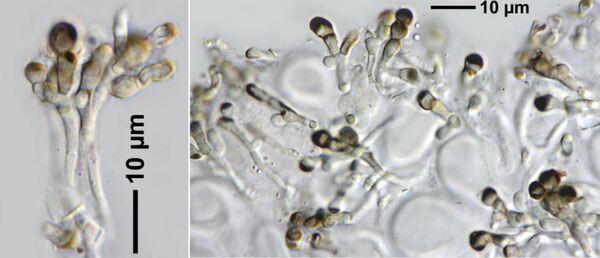
Felix Schumm – CC BY-SA 4.0
[16352], Mallorca (Süd): Nationalpark; 39,34322° N, 3,16764° E, 40 m. Leg. Schumm, Frahm & Lüth 12.03.2010, det. Schumm 2010.

Felix Schumm – CC BY-SA 4.0
[16352], Mallorca (Süd): Nationalpark; 39,34322° N, 3,16764° E, 40 m. Leg. Schumm, Frahm & Lüth 12.03.2010, det. Schumm 2010.
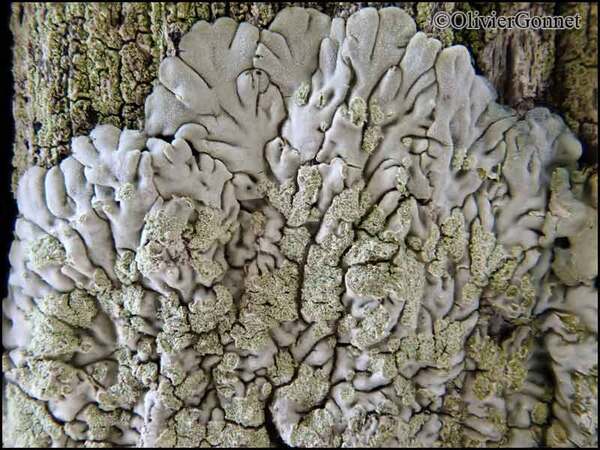
Courtesy Danièle et Olivier Gonnet - Source: https://www.afl-lichenologie.fr/Photos_AFL/Photos_AFL_D/Diploicia_canescens.htm
France, Sur piquet en châtaignier - Ajaccio - Corse
5/12/2014

Michel David - Source: http://www.lichensmaritimes.org/index.php?task=fiche&lichen=65&lang=en
France, Crozon
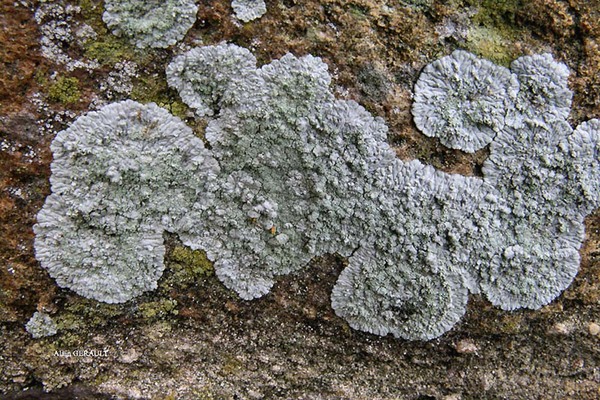
Alain Gerault - Source: http://www.lichensmaritimes.org/index.php?task=fiche&lichen=65&lang=en
France, Camfrout
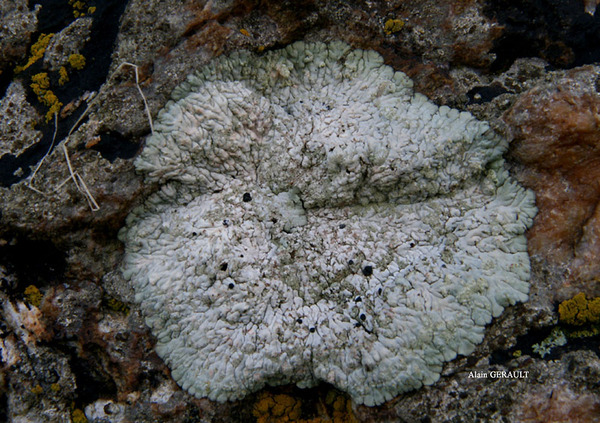
Alain Gerault - Source: http://www.lichensmaritimes.org/index.php?task=fiche&lichen=65&lang=en
France, Camfrout
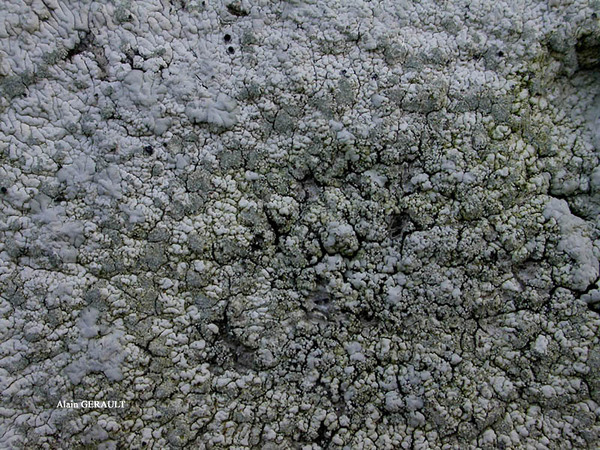
Alain Gerault - Source: http://www.lichensmaritimes.org/index.php?task=fiche&lichen=65&lang=en
France, Camfrout
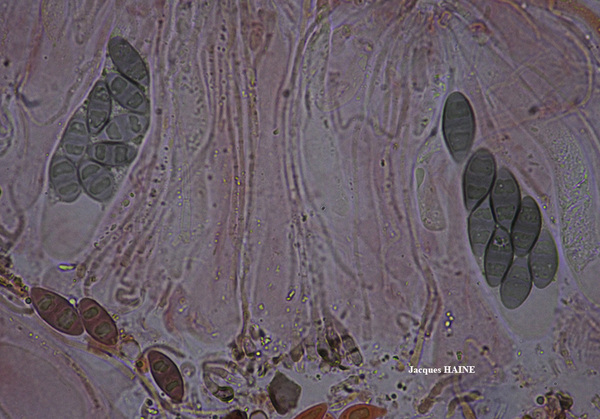
Jacques Haine - Source: http://www.lichensmaritimes.org/index.php?task=fiche&lichen=65&lang=en
France, St. Brieuc
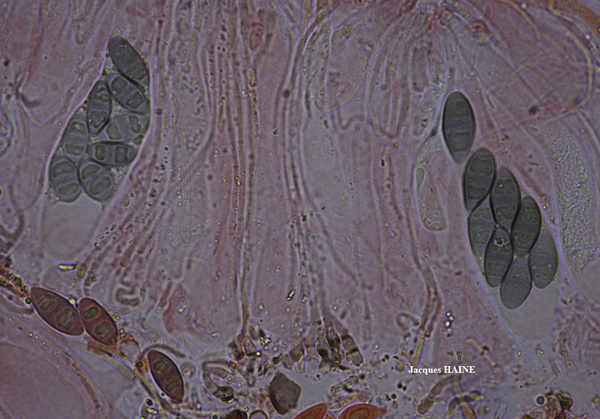
Jacques Haine - Source: http://www.lichensmaritimes.org/index.php?task=fiche&lichen=65&lang=en
France, St. Brieuc
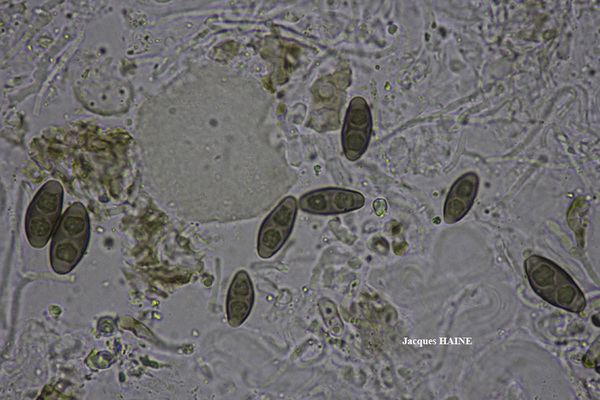
Jacques Haine - Source: http://www.lichensmaritimes.org/index.php?task=fiche&lichen=65&lang=en
France, St. Brieuc
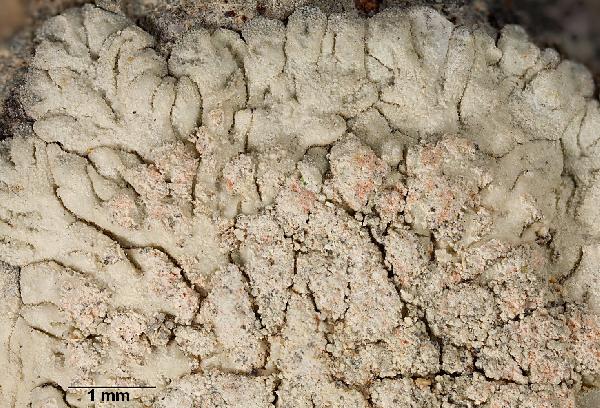
Ulrich Kirschbaum CC BY-SA 4.0 - Source: https://www.thm.de/lse/ulrich-kirschbaum/flechtenbilder
On volcanic rocks. Canary Islands; La Gomera-NW; nnw of Vallehermoso; n of the Ermita de Coromoto; surroundings of Chijere.
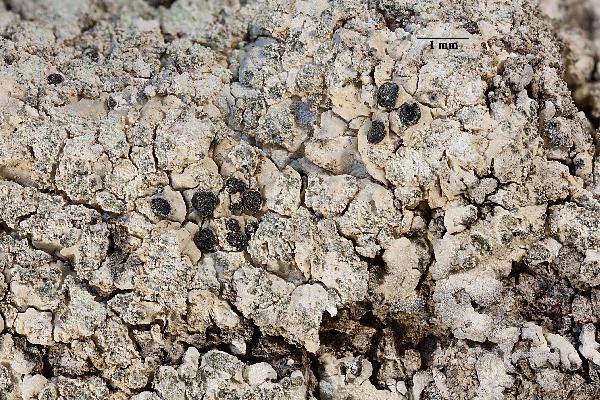
Ulrich Kirschbaum CC BY-SA 4.0 - Source: https://www.thm.de/lse/ulrich-kirschbaum/flechtenbilder
On volcanic rocks. Canary Islands; La Gomera-NW; nnw of Vallehermoso; n of the Ermita de Coromoto; surroundings of Chijere.
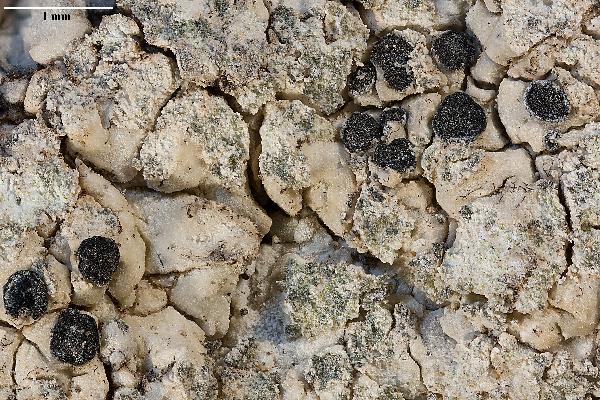
Ulrich Kirschbaum CC BY-SA 4.0 - Source: https://www.thm.de/lse/ulrich-kirschbaum/flechtenbilder
On volcanic rocks. Canary Islands; La Gomera-NW; nnw of Vallehermoso; n of the Ermita de Coromoto; surroundings of Chijere.
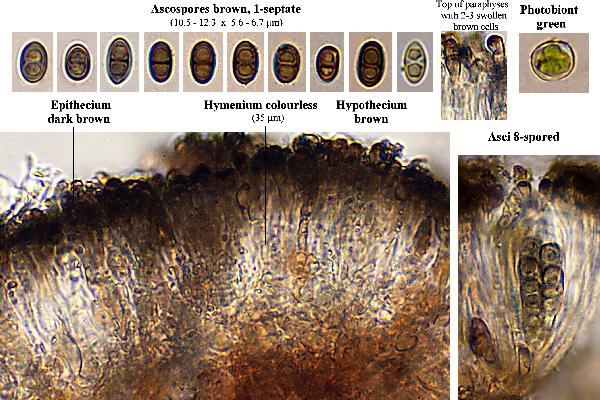
Ulrich Kirschbaum CC BY-SA 4.0 - Source: https://www.thm.de/lse/ulrich-kirschbaum/flechtenbilder
On volcanic rocks. Canary Islands; La Gomera-NW; nnw of Vallehermoso; n of the Ermita de Coromoto; surroundings of Chijere.
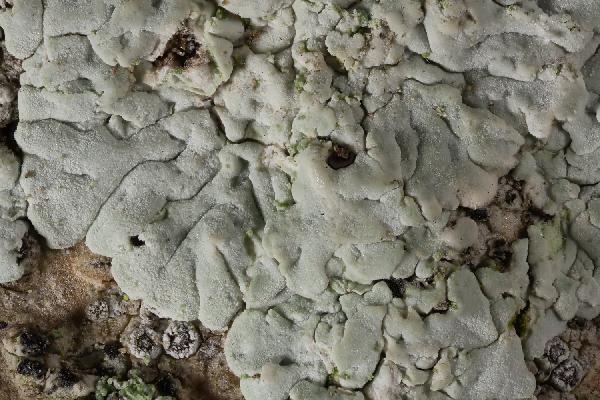
Ulrich Kirschbaum CC BY-SA 4.0 - Source: https://www.thm.de/lse/ulrich-kirschbaum/flechtenbilder
Spain. (Collected by M. Schessl).
Growth form: Crustose placodiomorph
Substrata: bark and rocks
Photobiont: green algae other than Trentepohlia
Reproductive strategy: mainly asexual, by soredia, or soredia-like structures (e.g. blastidia)
Most common in areas with a humid-warm climate (e.g. most of Tyrrenian Italy)
In underhangs rarely wetted by rain
Commonnes-rarity: (info)
Alpine belt: absent
Subalpine belt: absent
Montane belt: absent
Dry submediterranean belt: extremely rare
Humid submediterranean belt: rather common
Padanian area: absent
pH of the substrata:
| 1 | 2 | 3 | 4 | 5 |
Solar irradiation:
| 1 | 2 | 3 | 4 | 5 |
Aridity:
| 1 | 2 | 3 | 4 | 5 |
Eutrophication:
| 1 | 2 | 3 | 4 | 5 |
Poleotolerance:
| 0 | 1 | 2 | 3 |
Altitudinal distribution:
| 1 | 2 | 3 | 4 | 5 | 6 |
Rarity
absent
extremely rare
very rare
rare
rather rare
rather common
common
very common
extremely common
Loading data...
Occurrence data
Predictive map

Andrea Moro; Owner: Department of Life Sciences, University of Trieste
Italy, Friuli Venezia Giulia, Trieste, Trieste, Conconello
14/02/2017

G. Incerti; Owner: Department of Life Sciences, University of Trieste
Herbarium: TSB (31403)
2001/11/26

G. Incerti; Owner: Department of Life Sciences, University of Trieste
Herbarium: TSB (31403)
2001/11/26

P.L. Nimis; Owner: Department of Life Sciences, University of Trieste
Herbarium: TSB (14683)
2001/11/23
detail of soredia

P.L.Nimis; Owner: Department of Life Sciences, University of Trieste
Herbarium: TSB (38226)
2008.02.25

P.L.Nimis; Owner: Department of Life Sciences, University of Trieste
Herbarium: TSB (38226)
2008.02.25

P.L.Nimis; Owner: Department of Life Sciences, University of Trieste
Herbarium: TSB (38226)
2008.02.25

A. Moro; Owner: Department of Life Sciences, University of Trieste
Sicilia, TP, Erice, dintorni della città
2008.04.05

Andrea Moro; Owner: Department of Life Sciences, University of Trieste
Italy, Sicily, Trapani, Erice, Historical Center

Andrea Moro; Owner: Department of Life Sciences, University of Trieste
Italy, Sicily, Trapani, Erice, Historical Center

Andrea Moro; Owner: Department of Life Sciences, University of Trieste
Italy, Sicily, Trapani, Erice, Historical Center

Andrea Moro; Owner: Department of Life Sciences, University of Trieste
Italy, Sicily, Trapani, Erice, Historical Center

Andrea Moro; Owner: Department of Life Sciences, University of Trieste
italy, Friuli Venezia Giulia, Trieste, Trieste Karst near Borgo Grotta Gigante
16/02/2017

Andrea Moro; Owner: Department of Life Sciences, University of Trieste
Italy, Sicily, Trapani, Erice, Historical Center

Andrea Moro; Owner: Department of Life Sciences, University of Trieste
italy, Friuli Venezia Giulia, Trieste, Trieste Karst near Borgo Grotta Gigante
16/02/2017

Andrea Moro; Owner: Department of Life Sciences, University of Triedte
Italy, Friuli Venezia Giulia, Trieste, Trieste Karst, Rocca di Monrupino
20/02/2017

Andrea Moro; Owner: Department of Life Sciences, University of Trieste
Italy, Friuli Venezia Giulia, Trieste, Trieste, Conconello
14/02/2017

Andrea Moro; Owner: Department of Life Sciences, University of Trieste
Italy, Friuli Venezia Giulia, Trieste, Trieste, Conconello
14/02/2017

Andrea Moro; Owner: Department of Life Sciences, University of Trieste
Italy, Friuli Venezia Giulia, Trieste, Trieste, Conconello
14/02/2017

Andrea Moro; Owner: Department of Life Sciences, University of Trieste
Italy, Friuli Venezia Giulia, Trieste, Trieste, Conconello
14/02/2017

Andrea Moro; Owner: Department of Life Sciences, University of Trieste
Italy, Friuli Venezia Giulia, Trieste, Trieste, Conconello
14/02/2017

Andrea Moro; Owner: Department of Life Sciences, University of Trieste
Italy, Friuli Venezia Giulia, Trieste, Trieste, Conconello
14/02/2017

Felix Schumm – CC BY-SA 4.0
Image from: F. Schumm (2008) - Flechten Madeiras, der Kanaren und Azoren. Beck, OHG - ISBN: 978-3-00-023700-3

Felix Schumm – CC BY-SA 4.0
[16352], Mallorca (Süd): Nationalpark; 39,34322° N, 3,16764° E, 40 m. Leg. Schumm, Frahm & Lüth 12.03.2010, det. Schumm 2010.

Felix Schumm – CC BY-SA 4.0
[16352], Mallorca (Süd): Nationalpark; 39,34322° N, 3,16764° E, 40 m. Leg. Schumm, Frahm & Lüth 12.03.2010, det. Schumm 2010.

Felix Schumm – CC BY-SA 4.0
[16352], Mallorca (Süd): Nationalpark; 39,34322° N, 3,16764° E, 40 m. Leg. Schumm, Frahm & Lüth 12.03.2010, det. Schumm 2010.

Felix Schumm – CC BY-SA 4.0
[16352], Mallorca (Süd): Nationalpark; 39,34322° N, 3,16764° E, 40 m. Leg. Schumm, Frahm & Lüth 12.03.2010, det. Schumm 2010.

Felix Schumm – CC BY-SA 4.0
[16352], Mallorca (Süd): Nationalpark; 39,34322° N, 3,16764° E, 40 m. Leg. Schumm, Frahm & Lüth 12.03.2010, det. Schumm 2010.

Felix Schumm – CC BY-SA 4.0
[16352], Mallorca (Süd): Nationalpark; 39,34322° N, 3,16764° E, 40 m. Leg. Schumm, Frahm & Lüth 12.03.2010, det. Schumm 2010.

Felix Schumm – CC BY-SA 4.0
[16352], Mallorca (Süd): Nationalpark; 39,34322° N, 3,16764° E, 40 m. Leg. Schumm, Frahm & Lüth 12.03.2010, det. Schumm 2010.

Courtesy Danièle et Olivier Gonnet - Source: https://www.afl-lichenologie.fr/Photos_AFL/Photos_AFL_D/Diploicia_canescens.htm
France, Sur piquet en châtaignier - Ajaccio - Corse
5/12/2014

Michel David - Source: http://www.lichensmaritimes.org/index.php?task=fiche&lichen=65&lang=en
France, Crozon

Alain Gerault - Source: http://www.lichensmaritimes.org/index.php?task=fiche&lichen=65&lang=en
France, Camfrout

Alain Gerault - Source: http://www.lichensmaritimes.org/index.php?task=fiche&lichen=65&lang=en
France, Camfrout

Alain Gerault - Source: http://www.lichensmaritimes.org/index.php?task=fiche&lichen=65&lang=en
France, Camfrout

Jacques Haine - Source: http://www.lichensmaritimes.org/index.php?task=fiche&lichen=65&lang=en
France, St. Brieuc

Jacques Haine - Source: http://www.lichensmaritimes.org/index.php?task=fiche&lichen=65&lang=en
France, St. Brieuc

Jacques Haine - Source: http://www.lichensmaritimes.org/index.php?task=fiche&lichen=65&lang=en
France, St. Brieuc

Ulrich Kirschbaum CC BY-SA 4.0 - Source: https://www.thm.de/lse/ulrich-kirschbaum/flechtenbilder
On volcanic rocks. Canary Islands; La Gomera-NW; nnw of Vallehermoso; n of the Ermita de Coromoto; surroundings of Chijere.

Ulrich Kirschbaum CC BY-SA 4.0 - Source: https://www.thm.de/lse/ulrich-kirschbaum/flechtenbilder
On volcanic rocks. Canary Islands; La Gomera-NW; nnw of Vallehermoso; n of the Ermita de Coromoto; surroundings of Chijere.

Ulrich Kirschbaum CC BY-SA 4.0 - Source: https://www.thm.de/lse/ulrich-kirschbaum/flechtenbilder
On volcanic rocks. Canary Islands; La Gomera-NW; nnw of Vallehermoso; n of the Ermita de Coromoto; surroundings of Chijere.

Ulrich Kirschbaum CC BY-SA 4.0 - Source: https://www.thm.de/lse/ulrich-kirschbaum/flechtenbilder
On volcanic rocks. Canary Islands; La Gomera-NW; nnw of Vallehermoso; n of the Ermita de Coromoto; surroundings of Chijere.





